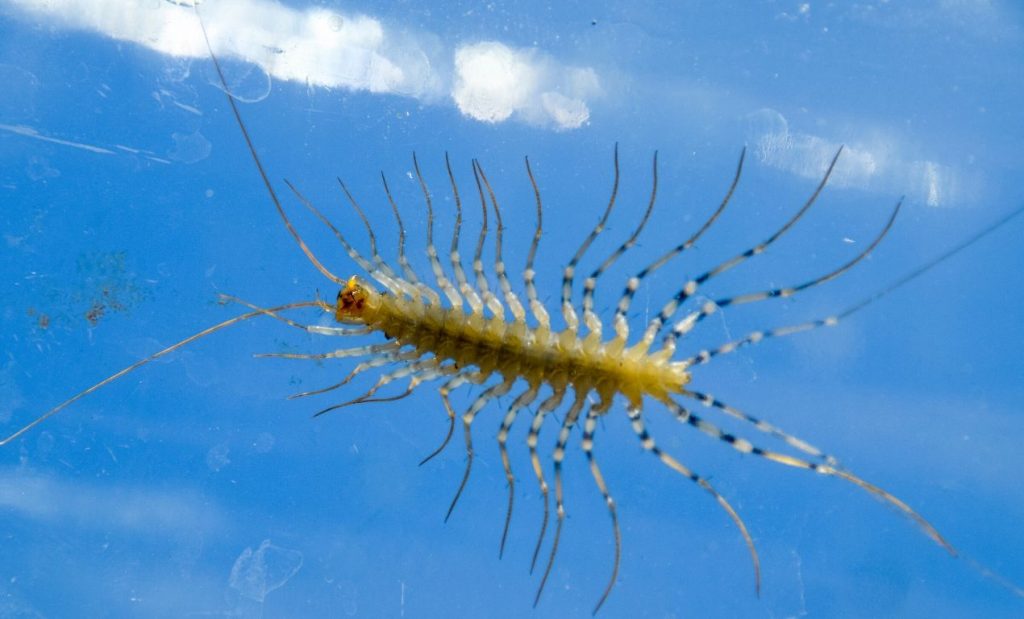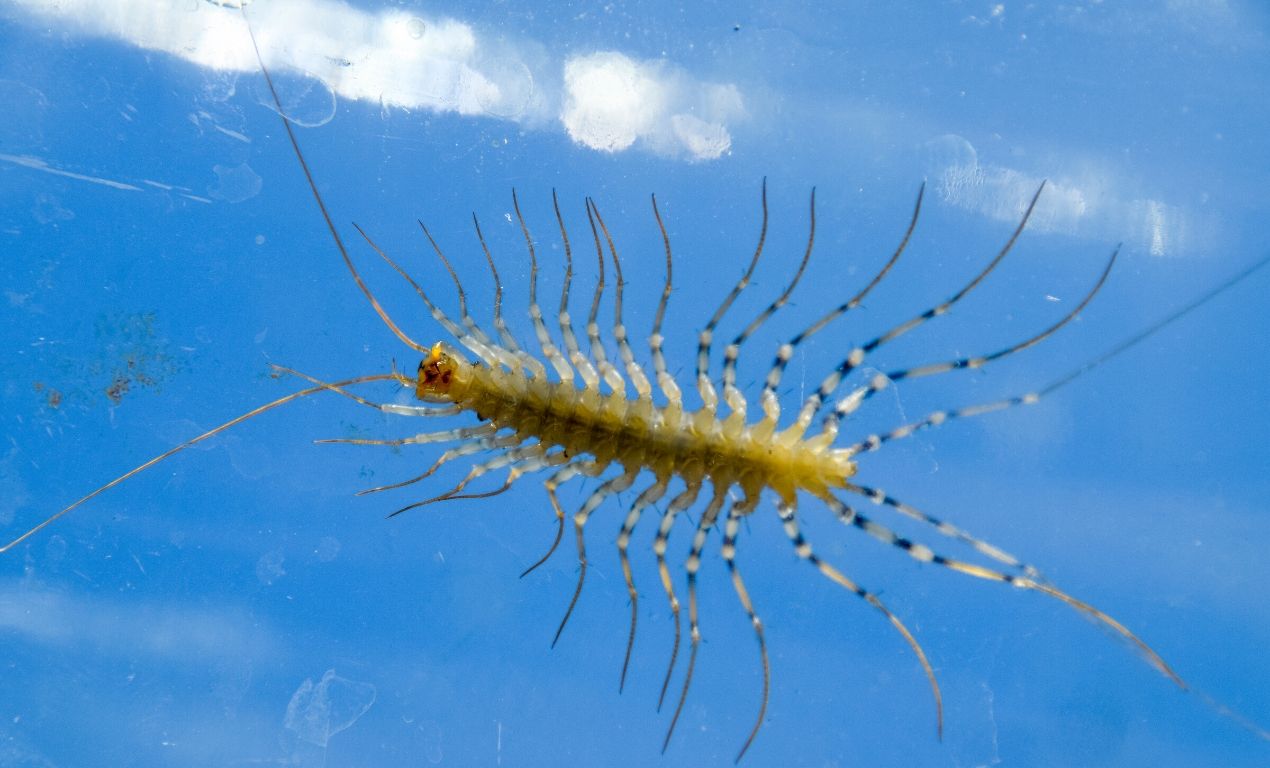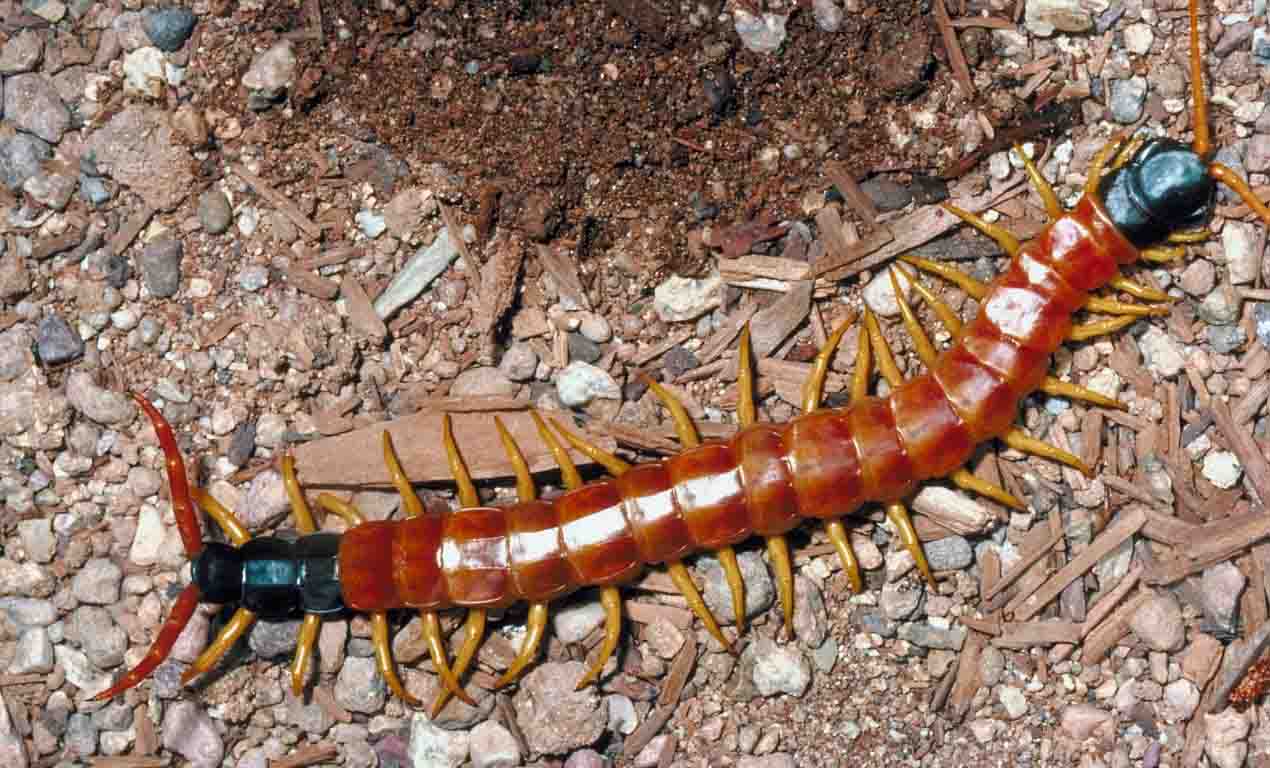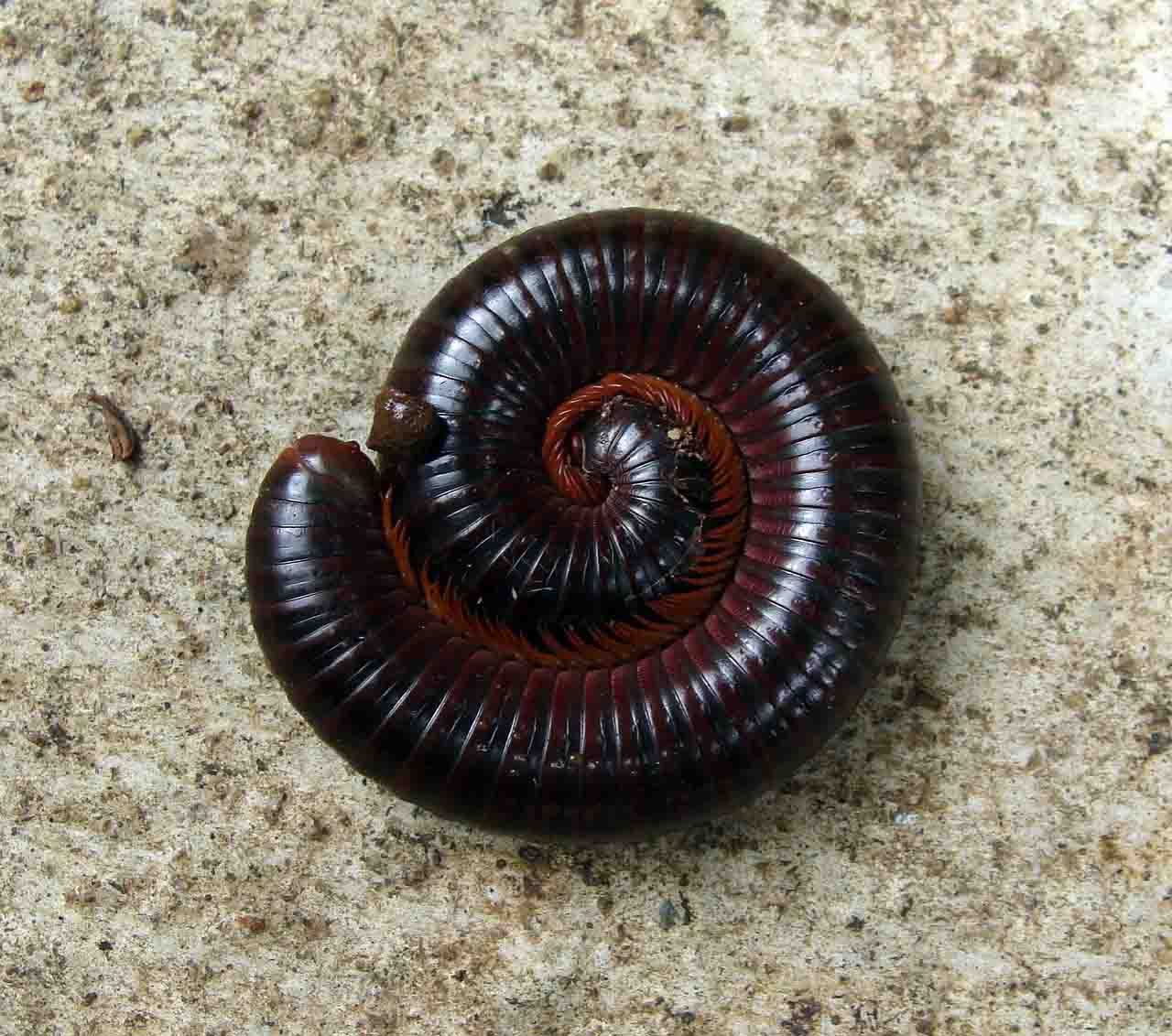
 Centipedes are predatory arthropods. They belong to Chilopoda of the subphylum Myriapoda. They are long-bodied creatures and have one pair of legs for every body segment. Most centipedes are venomous. They inflict a painful bite and inject venom through their pincer-like appendage, called forcipules. Though they get considered as hundred legged creature, no centipedes have such legs. Their legs vary between 30 to 350 and have an odd number of legs. Centipedes are predominantly carnivores. With that you have probably seen the swimming or going underwater.
Centipedes are predatory arthropods. They belong to Chilopoda of the subphylum Myriapoda. They are long-bodied creatures and have one pair of legs for every body segment. Most centipedes are venomous. They inflict a painful bite and inject venom through their pincer-like appendage, called forcipules. Though they get considered as hundred legged creature, no centipedes have such legs. Their legs vary between 30 to 350 and have an odd number of legs. Centipedes are predominantly carnivores. With that you have probably seen the swimming or going underwater.
So, can centipedes breath underwater? No, centipedes can’t breath underwater. They can go underwater, stay there for about a minute or so but then have to come out as they need oxygen which they need to breath in from air. Centipedes doesn’t have any organ that can absorb the oxygen from water much like us.
Description
Centipedes have rounded and flathead, having a pair of antennae in the front. They have a couple of elongated mandibles and two pairs of maxillae. The first pair of limbs extends and covers its mouth. These legs end with sharp claws. These claws have venom glands, which paralyzes its prey.
The size of centipedes varies between a few millimeters to twelve inches. They live in varying environments. Those living in caves are pale in color since they lack pigmentation. They are generally red and brown. There are more than 8,000 species of centipedes found worldwide.
Forcipules are found only in centipede. We see this pincer-like appendage on their first pair of legs, which ends in sharp claws. The venom gland runs thro’ a tube to the end of each claw.
The centipedes have fifteen or more segments behind the head. The last two sections are smaller and don’t carry any legs. Every pair of legs gets more extended than the one in front. The final segment has the reproductive part, which is known as telson.
Most specimens of centipedes lack eyes. Some have ocelli, but they hardly have a vision and can only discern between light and shade. On the underside of their antennas, there are sensory cells, which can detect vibration and maybe a sense of hearing.
They use their antennas to seek out their prey. Have a simple digestive system, and the digestive glands are attached to their mouthparts. Like insects, centipedes breathe through tracheal system, with a small opening or spiracle, present on each body segment. Malpighian tubules get used to excrete waste.
Since they lack the waxy cuticle of insects and arachnids, we find centipedes in a moist environment. We see them in the soil, under stones, leaf litter, or inside dead-wood.
Lifecycle
Centipedes do not copulate for reproduction. Males leave their sperm for the females to find them. Some male species entice the females to their sperm. The females swallow them, and once fertilization takes place, eggs get hatched.
Centipedes usually lay their eggs in the soil and other moist places and cover them with foliages. Some species guard them till they hatch. 10 to 50 eggs get laid by the females. Hatching of the eggs may vary from one to few months.
Adult centipedes can live between five to ten years, depending upon the species.
Ecology
Centipedes hardly feed on vegetable matter. They prey on organic matter, and they feed on all types of insects, reptiles, small animals, and amphibians. Their defense mechanism is their claws, venom, and speed.
Since their exoskeleton is devoid of wax, they lose water quickly. Also, their excreta contain ammonia, which requires water to react with nitrogen. Hence they prefer moist surroundings to survive.
Centipedes continue to molt during their adulthood. In case they lose some legs to a predator, they are seen growing new legs. They are mostly nocturnal creatures and prefer darkness to sunshine.
Habitat
Centipedes prefer to live in moist, damp places. They usually live outdoors, under the boulder, inside the soil, under the fallen tree or garbage dump, which attracts lots of insects, which they feed on.
During the summer or winter, when the climate outside is unbearable, they take refuge in the human living spaces. They love the damp basement, under the damaged tile in the washrooms or under the kitchen sink.
Centipedes generally avoid water. They can swim for a short while but soon drown due to lack of oxygen. They take in oxygen from the atmosphere thro’ small pores located under their legs.
Respiratory System
Centipedes have a tracheal tube respiratory system to breathe. This has several parts.
Spiracles: They are openings on the exoskeleton, thro’ which the air enters the body of a centipede. They have this opening in most of the segments. The anterior and few posterior segments lack these opening
Trachea:This collected air gets sent to their many tracheas. This trachea delivers the air from outside to its various parts.
Tracheoles: Some of the air get also sent to their much smaller tracheoles, which get connected to individual cells.
Like humans, centipedes take in oxygen thro’ their tracheal system and expend carbon dioxide and some water vapor.
Swimming Centipede
 A few years back, the first known amphibious centipede got found in Southeast Asia. They were of a group known as Scolopendra Cataracta and grew up to 8 inches in length. Like all centipedes, they are venomous and carnivores. There are only four specimens of this species available to scientists around the world.
A few years back, the first known amphibious centipede got found in Southeast Asia. They were of a group known as Scolopendra Cataracta and grew up to 8 inches in length. Like all centipedes, they are venomous and carnivores. There are only four specimens of this species available to scientists around the world.
This centipede is greenish-black in color and has twenty pairs of legs. By chance, this species got found near the river bank. When it got threatened, than escaping under the foliages, it dived into the water and swam behind a submerged rock and hid there, underwater?
Since this specimen got first found near a waterfall, this variety is also known as waterfall centipede. We think that this variety of centipede goes underwater at night to feed on aquatic and amphibians, who are taken by surprise.
Their carapace is very hydrophobic like the duck. When they emerge out of the water, the water will roll out of their bodies, and they will be dry. They can either scamper along the stream or swim underwater like an eel. They swim by undulating their bodies. It is still a mystery how they survive so long underwater without oxygen!
Centipedes vs. Millipedes
Both of them have segmented bodies and belong to Myriapoda. Both breathe thro’ spiracles, and centipedes have no direct copulatory organs. However, there seem to be many differences between the two:
Physical features
- Centipedes are arthropods and terrestrial creatures. They are flexible and have one pair of legs per segments
- Millipedes, on the other hand, belongs to class Diplopoda. They are rigid and have a subcylindrical shape. They have two pairs of legs per section.
- Legs of centipedes point out from their bodies. Millipede legs point inwards
Movement
- Centipedes are quick in their movement. Millipedes move slowly.
Feeding habit
- They vary in their feeding habits too. Centipedes are carnivores and incapacitate its prey thro’ injecting venom in their bodies and then feeding on them. They do not feed on vegetation.
- Millipedes, on the other hand, feed on decaying organic matter. They also feed on roots and leaves. They are detritivores.
Defense system
- Centipedes have claws on their first pair of extended legs, which injects venom inside the prey to either kill or numb them.
- Millipedes do not have any stinging structure. They secrete a chemical to protect itself from other prey and also rolls over tightly when it feels threatened. This secretion can injure the victim through burning or scalding.
Habitat
- Both of them love to stay in a moist environment like soil, under rocks, inside rotting bark of trees, or near a water body.
Can Millipedes Swim?
Millipedes like the centipede cannot swim. They stay near water sources since they also lose their body moisture quickly, like the centipede. However, there are some species of millipedes in the flood plains. These survive a few months underwater, but not for long.
Can Centipedes Survive In The Water?
Centipedes get generally found near all water sources. They can sometimes survive inside the water, but not for long. Since they need oxygen just like humans, their breathing pores cannot operate underwater. Hence, if they stay long underwater, they drown.
Some Facts About Centipedes And Millipedes


- Both cannot get classified as insects. They are very similar to lobsters and shrimps.
- However, they are both land dwellers, though they have an affinity for water sources.
- They are both nocturnal and forage for food after dark.
- They don’t carry any diseases, which can affect humans, animals, and plants.
- A body of a centipede has a covering of softshell, and their color varies between white, yellow, red, orange, black, or brown. But most of them are reddish-brown.
- The first pair of legs of a centipede is not for walking. It is used to hold its prey and inject poison.
- Centipedes can bite humans in self-defense though such bite is not fatal.
- Centipedes and millipedes are one of the oldest land animals. They are on the earth for the last 430 million years.
- Some species of centipedes add legs during their adulthood, though most hatch with their complements of legs.
- Millipedes mean 1,000 legs. However, no millipedes have that many numbers of legs.
- Millipedes secrete chemicals in self-defense. Coming in contact with this leads to:
- Darkening of skin in touch with this solution.
- It creates burning and intense itching of the skin around the affected area.
- The skin would get blistered.
- You would feel little nausea.
- If the chemical solution gets into your eyes, you could expect inflammation of eyes and eye-lids. It can lead to blindness if in contact with the eyes directly.
- Millipedes are mostly dark orange, brown, or black. They have a small antenna in front.
- Millipedes do not bite humans.
- Millipedes lay about 100 eggs.
- When the eggs hatch, nymph millipedes emerge with a minimum number of body segments. As they molt during adulthood, more segments get formed.
- Male millipedes transfer his sperm packet thro’ genital organ into the female vulva.
- There are about 12,000 species of millipedes.
Conclusion
Centipedes live near water sources and a moist environment. Since their body segment does not have a waxy coating, they continuously lose moisture from their bodies. They love to live in the wet soil, under a boulder, inside dead-wood, around garbage bin and composts.
Since they take in oxygen from the atmosphere through its tiny pores in each of their body segments, they would not be able to do so inside water. Even if they move for a brief period inside water, they would soon drown if they do not reach the land surface to “breathe.”
An amphibious centipede has recently got found in South East Asia, which can swim in the water. However, researchers are studying this creature to find out more about the way they take in oxygen and move inside the water. Hence, in conclusion, centipedes, in general, cannot breathe underwater!
Welcome to my blog. I have been doing pest control for years since my house, garden and pets were always attacked by various kinds of pests and as a result I had to know proper pest control techniques that works. In this blog I share all the tips and tricks that I know and I hope you’ll find it helpful.
